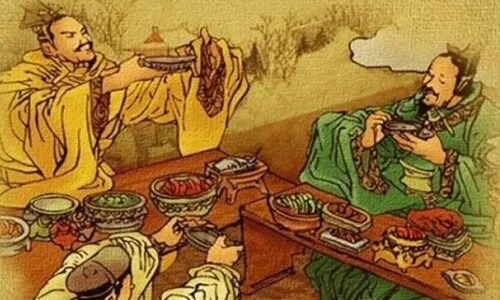
Posters released by Changjiang Daily on June 4 to encourage people to use gongkuai Photo: Snapshot of Sina Weibo
During Chinese New Year, hundreds of villagers and tourists in East China's Fujian Province gathered together in front of a tulou, a traditional communal residence of the Hakka people, to enjoy hand-made beef balls cooked in a huge pot the diameter of which can reach four meters.Jiang Yanzi, a local resident and also a tour guide of the Yongding Tulou in Fujian Province, told the Global Times on Tuesday that she and other villagers often bring their own spoons and bowls during the festival to enjoy the communal and delicious meal around the pot.
However, due to the outbreak of COVID-19 pandemic, such events will no longer be permitted anymore. It seems that in the wake of the virus crisis, China's traditional communal eating culture may never be the same again.
New customs
On June 1, Beijing released regulations concerning dining that stated gongkuai and gongshao, or serving chopsticks and spoons, as well as individual servings should be adopted as means to prevent the spread of COVID-19.
Local authorities in Shanghai also proposed similar rules on February 23 for people to use gongkuai, according to reports.
My Hot Pot, a traditional Beijing restaurant that opened eight years ago in Wangfujing shopping street, has introduced serving chopsticks since March, Li, the restaurant's manager, told the Global Times on Tuesday.
He also noted that while the restaurant has served customers individual hot pots, as opposed to the single shared hot pot at many other restaurants, since its opening for hygiene reasons, he never imagined that serving separate portions would become a trend in China.
"Almost all the restaurants at the shopping mall are using serving chopsticks and spoons, and provide individual portions. Tables are also kept at least one meter from each other to maintain safe social distancing," Li said.
Coming together
While the new COVID-19 measures may seem to run counter to tradition, in actuality communal and individual dining have a long history in China.
The serving of individual portions has roots in primitive society: gathered food was distributed among the tribe before eating. In China, this later evolved into a ritualized system that embodied the expression and ideology of social hierarchy. For instance, during the Zhou Dynasty (1046 BC-256 BC), the emperor has his own table with much more food, in contrast to the ministers sitting across from him at a single table with fewer dishes.

Individual dining in ancient China Photo: Snapshot of Sina Weibo
After the Song Dynasty (960-1279), as cooking methods became more diversified and new types of furniture such as round dining tables made an appearance, communal dining among families in which everyone shared several dishes began to become more prominent and eventually became more popular than individual dining during the Qing Dynasty (1644-1911), Zhang Yiwu, a Chinese literature professor at Peking University, told the Global Times on Tuesday.In modern times, communal-style dining has become a habit deeply ingrained in the daily lives of Chinese as an expression of closeness and intimacy with family members. Zhang said that due to this, he feels that it will not be completely replaced by separate portions even under the influence of the new pandemic.
"However, serving utensils including chopsticks and spoons can reduce the risk of infection posed by family-style dining, so the two dining styles will continue to exist in our daily lives," Zhang said.
From what Li has seen at his restaurant, although serving chopsticks are being provided to customers, people are still not quite used to it.
"Some customers who pay attention to public hygiene use them, but others will still take food from serving dishes using their own utensils out of habit," he explained.
It certainly seems that changing the habits of Chinese will be difficult.
Although the concept of individual portions was promoted heavily during the SARS outbreak in 2003, studies show that while 12.1 percent of diners "always" used serving chopsticks at the time, this number decreased to 11.2 percent in 2006, according to a report from the People's Daily.






